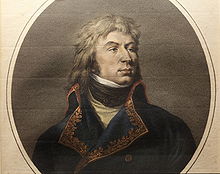- Jean Reynier
-
Jean Louis Ebénézer Reynier (14 January 1771 – 27 February 1814) rose in rank to become a French army general officer during the French Revolutionary Wars. He led a division under Napoleon Bonaparte in the French Campaign in Egypt and Syria. During the Napoleonic Wars he continued to hold important combat commands, eventually leading an army corps during the Peninsular War in 1810-1811 and during the War of the Sixth Coalition in 1812-1813.
Contents
Revolution
Reynier joined the French army as a gunner in 1792 and fought at the Battle of Jemappes that year. He received promotion to general of brigade in January 1795. He was General Jean Moreau's chief-of-staff in 1796 and soon became a general of division. He went on Napoleon's Egyptian expedition in 1798 and commanded a division at the Battle of the Pyramids, the Siege of El Arish and the siege of Acre. Later, under the command of General Jacques-Francois Menou he defended against the British counter-invasion of Egypt in 1801. His division was present but not engaged in the Battle of Alexandria. After returning to France, Reynier killed a fellow general in a duel and was under a cloud for a time.[1]
Empire
Reynier fought with the army of Marshal André Masséna in the 1805 Italian theater. On 24 November, his 2nd Division captured Prince Viktor Rohan's 4,400 Austrians at Castelfranco Veneto.[2] Reynier's 6,000 Frenchmen routed the 10,000-man army of the Bourbon Kingdom of Naples and Sicily at the Battle of Campo Tenese on 9 March 1806. This victory helped Napoleon to install his brother Joseph Bonaparte on the throne of the newly-created Napoleonic Kingdom of Naples. On 4 July of that year, a British raiding force inflicted a severe drubbing on an overconfident Reynier at the Battle of Maida in southern Italy.[3] Reynier was later able to reassert French control of the area via the French victory at Mileto and served under King Joseph as his Minister of War and Marine.
During the Battle of Wagram in 1809, Reynier commanded 129 artillery pieces and 8,475 soldiers on the Island of Lobau.[4] This impressive array of cannon helped stop a dangerous flanking attack by Johann von Klenau's Austrian VI Armeekorps.[5] Sent to the Iberian Peninsula in 1810, he commanded the II Corps under Masséna at the Battle of Bussaco, the Lines of Torres Vedras, and the Battle of Sabugal in Portugal. Before Bussaco, Reynier and other generals urged Masséna to order the assault which turned out to be unsuccessful.[6] His corps was not seriously engaged at the Battle of Fuentes de Onoro in Spain. In 1811, Napoleon named him a Count of the Empire.
During the Russian campaign of 1812, Reynier led the VII Corps which was composed of Saxons. Together with an allied Austrian force under Karl Schwarzenberg, he operated well to the south of the major fighting. After fighting inconclusive battles with the Russians at Gorodeczna and Wolkowysk, he retreated when he learned of the main army's disaster.
Leading the Saxon corps plus an attached French division, Reynier fought at the battles of Bautzen, Grossbeeren and Dennewitz in 1813. During the climactic Battle of Leipzig, his Saxon troops suddenly changed sides. When a key bridge was blown up too quickly, Reynier was trapped and captured with his remaining French soldiers. He returned to France after a prisoner exchange in February 1814 but died two weeks later.[1]
References
Books
- Bowden, Scotty & Tarbox, Charlie. Armies on the Danube 1809. Arlington, Texas: Empire Games Press, 1980.
- Chandler, David. Dictionary of the Napoleonic Wars. New York: Macmillan, 1979. ISBN 0-02-523670-9
- Chandler, David. The Campaigns of Napoleon. New York: Macmillan, 1966.
- Horward, Donald (ed.), Pelet, Jacques. The French Campaign in Portugal 1810-1811. Minneapolis, Minn.: University of Minnesota Press, 1973. ISBN 0-8166-0658-7
- Smith, Digby. The Napoleonic Wars Data Book. London: Greenhill, 1998. ISBN 1-85367-276-9
External links
Footnotes
Categories:- French generals
- French commanders of the Napoleonic Wars
- Military leaders of the French Revolutionary Wars
- French military personnel of the French Revolutionary Wars
- 1771 births
- 1814 deaths
Wikimedia Foundation. 2010.

